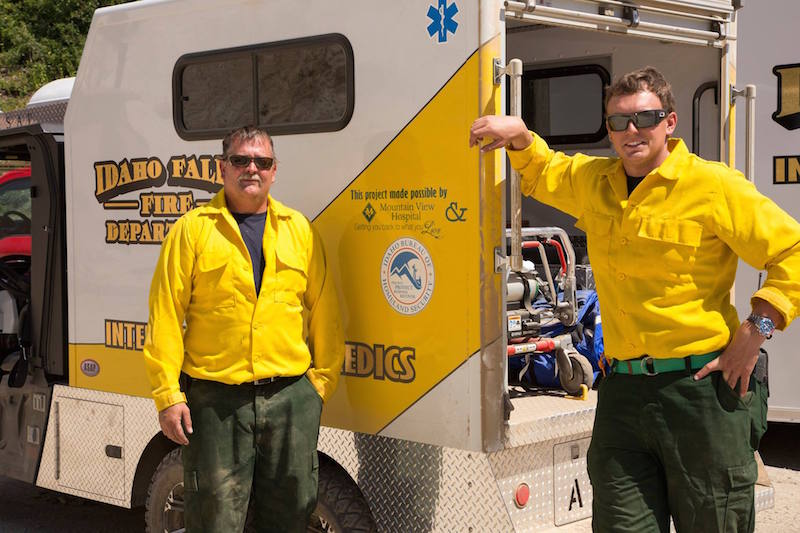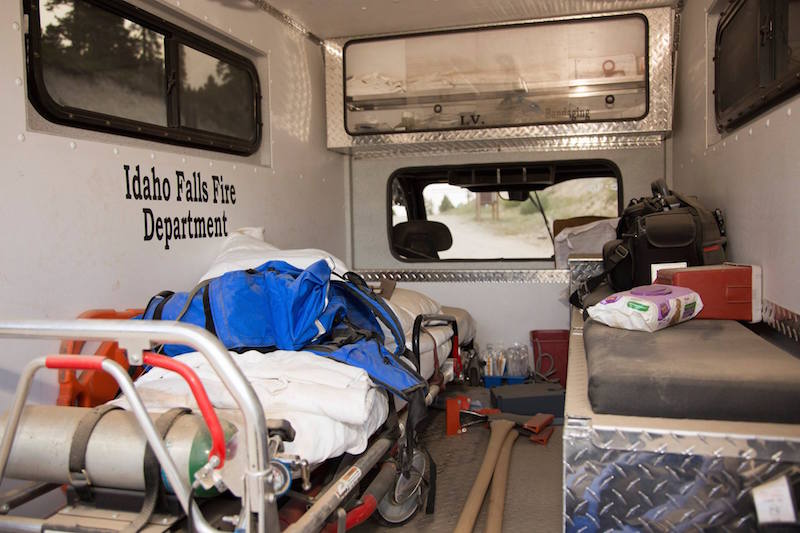Idaho Falls Off-Road Ambulance Makes Debut at Pioneer Fire
Published at | Updated at
IDAHO CITY — It’s skinny and squarish with a black cab, white body and six thickly treaded mini-wheels. Firefighters have never seen anything quite as cute at a wildland fire.
An off-road mini-ambulance from the Idaho Falls Fire Department made its debut at the Pioneer Fire on Monday. Paramedic Connor Cook and EMT Jess Morgan drove five hours to Idaho City, pulling the ambulance behind them in an enclosed trailer to report for duty at the incident command post of the fire, which is burning north of town.
For the next two weeks, Cook and Morgan will provide off-road ambulance service for injured firefighters, likely for the first time ever at an Idaho wildfire. The fire’s medical unit leader, Curtis Baker, ordered the ambulance as soon as he heard about it.
“On the circumstances of this fire, with the remoteness and inaccessibility for ambulance access, it’s the perfect resource to have,” said Baker.
After a feverish 48 hours of paperwork, Cook and Morgan, both wildland-qualified, arrived at Idaho City and began drawing attention as soon as they unloaded their ambulance.
“It kind of stops people in their tracks,” said Cook. Baker joked that he was “extremely jealous,” as soon as he saw it. At morning briefing on Tuesday, he suggested firefighters take a look at it. “That thing is pretty rad,” he told the assembled group.
The mini-ambulance has a gurney, monitors, siren and flashing lights, just like a full-size one. But by shrinking it and adding a Polaris chassis, the mini-ambulance can travel on smaller, rougher trails to extract injured firefighters from places that a normal ambulance could never reach.
The off-road ambulance will then deliver patients to a road ambulance or to a helispot for evacuation to hospital, saving patients from a rough, slow evacuation and saving their crewmates from performing a difficult rescue by hand.
“Sometimes getting firefighters out quickly is a matter of life and death,” said Morgan.
Previously the Idaho Falls Fire Department has used the off-road ambulance for back-country rescues and also at public events where a full-size ambulance might have trouble getting through crowds.
Before the fire department acquired the off-road ambulance, the Bonneville County Sheriff’s Department was in charge of Search & Rescue in the Idaho Falls area and regularly transported back-country patients in a cart pulled by a four-wheeled all-terrain vehicle.
Riding on a gurney in an air-conditioned mini-ambulance makes for a much smoother ride. Although its squarish high shape might make it look tippy, Cook and Morgan both say that looks are deceiving, and the ride is surprisingly stable.
Off-road ambulance staff all take a week-long driving course, which includes driving on steep slopes. They also ride in the back to feel for themselves how a patient with a painful back or hip injury might experience the ride.
The Idaho Falls Fire Department is aiming to make a reputable name for itself in the wildland world by providing a unique service that aids the national fire-fighting effort. Baker, the medical unit leader for the fire, says off-road ambulances could become more common on wildland fires.
“It’s only going to be more and more of a priority with the increased emphasis on safety and the idea that everyone goes home,” he said.
And a big question remains: Do Morgan and Cook hit the siren when they’re evacuating a patient from the remote back-country? Deer might move out of their way anyway, Morgan says. “But, if they don’t,” he added, “we’re ready for them.”




